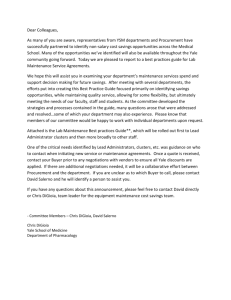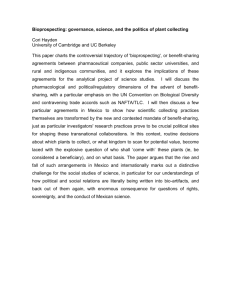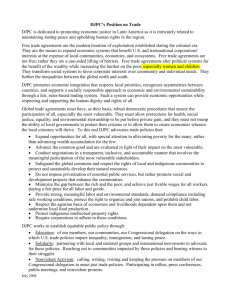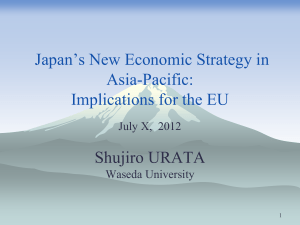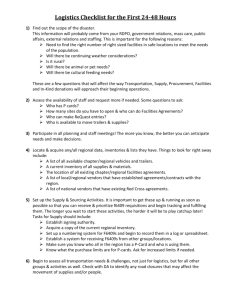Lecture14notes
advertisement
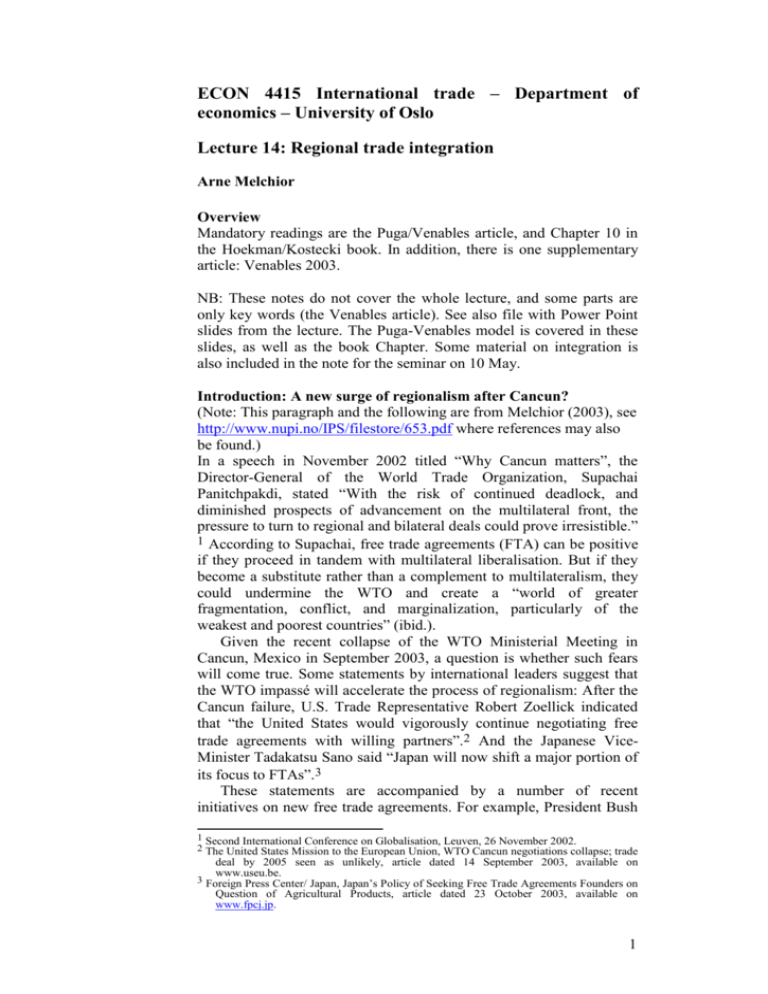
ECON 4415 International trade – Department of economics – University of Oslo Lecture 14: Regional trade integration Arne Melchior Overview Mandatory readings are the Puga/Venables article, and Chapter 10 in the Hoekman/Kostecki book. In addition, there is one supplementary article: Venables 2003. NB: These notes do not cover the whole lecture, and some parts are only key words (the Venables article). See also file with Power Point slides from the lecture. The Puga-Venables model is covered in these slides, as well as the book Chapter. Some material on integration is also included in the note for the seminar on 10 May. Introduction: A new surge of regionalism after Cancun? (Note: This paragraph and the following are from Melchior (2003), see http://www.nupi.no/IPS/filestore/653.pdf where references may also be found.) In a speech in November 2002 titled “Why Cancun matters”, the Director-General of the World Trade Organization, Supachai Panitchpakdi, stated “With the risk of continued deadlock, and diminished prospects of advancement on the multilateral front, the pressure to turn to regional and bilateral deals could prove irresistible.” 1 According to Supachai, free trade agreements (FTA) can be positive if they proceed in tandem with multilateral liberalisation. But if they become a substitute rather than a complement to multilateralism, they could undermine the WTO and create a “world of greater fragmentation, conflict, and marginalization, particularly of the weakest and poorest countries” (ibid.). Given the recent collapse of the WTO Ministerial Meeting in Cancun, Mexico in September 2003, a question is whether such fears will come true. Some statements by international leaders suggest that the WTO impassé will accelerate the process of regionalism: After the Cancun failure, U.S. Trade Representative Robert Zoellick indicated that “the United States would vigorously continue negotiating free trade agreements with willing partners”.2 And the Japanese ViceMinister Tadakatsu Sano said “Japan will now shift a major portion of its focus to FTAs”.3 These statements are accompanied by a number of recent initiatives on new free trade agreements. For example, President Bush 1 Second International Conference on Globalisation, Leuven, 26 November 2002. 2 The United States Mission to the European Union, WTO Cancun negotiations collapse; trade deal by 2005 seen as unlikely, article dated 14 September 2003, available on www.useu.be. 3 Foreign Press Center/ Japan, Japan’s Policy of Seeking Free Trade Agreements Founders on Question of Agricultural Products, article dated 23 October 2003, available on www.fpcj.jp. 1 announced in October 2003 plans to negotiate a free trade agreement between USA and Thailand. Japan and South Korea announced the start of free trade negotiations. As will be shown below, these are only two out of a large number of recent signals, plans, negotiations or conclusions concerning FTAs. In the Appendix, a list of agreements and initiatives for selected countries is presented. The increased focus on FTAs after Cancun is not a fundamentally new development, but rather an acceleration of an imminent trend. A new feature of this trend is an extension of FTAs in global space: Earlier regionalism has been more local in scope, by focusing on integration within continents or geographically close countries. Recently, FTAs have expanded across continents and worldwide; with the possible effect of creating a “global race for bilateral market access”. Earlier, FTAs have deepened regional economic integration, while the WTO (and earlier GATT) has been in charge of global trade integration. With a new trend towards inter-continental FTAs, this division of labour has become blurred. When some countries engage in bilateralism, the incentive increases for others to follow suit: If competitors obtain privileged access to important export markets due to FTAs, there is an incentive for adversely affected countries to negotiate similar deals. On several occasions, this has been a prime argument for bilateral deals, and the more agreements that already exist, the more convincing will this argument be. Hence the process may quickly become self-enforcing. A danger of such bilateralism is related to the fate of the less popular partners for such “marriages”. Given the prevalence of rich and upper middle income countries in the FTA business, there is a risk of the poorest countries being excluded from the gains from FTAs. Already, almost half of world trade is subject to free trade agreements or trade preferences, and hence not treated according to the “Most Favoured Nation” (MFN) principle of the WTO. As the network of FTAs expands, the MFN treatment may actually become the least favourable trade conditions available. Hence paradoxically, WTO rules may – worded provocatively – become the “least favoured nations” treatment. Background: From regional to global free trade agreements Parallel to the evolution of the post-war world trade system, regionalism has continuously played a significant role. The formation of the EEC in 1958, followed by EFTA in 1960, were the cornerstones of the ever widening and deepening process of European integration, with the current eastward enlargement of the EU as the last step so far. During the 1960s, a number of other regional trading blocs were also formed between developing countries, but in general, these were less ambitious and less successful compared to Western European integration. Hence the first stage of regionalism, lasting from the late 1950s until the late 1980s, was characterised by successful regional integration in Western Europe, and a mixed outcome of several initiatives in the developing world. 2 During the first stage of regionalism, the US strongly favoured multilateral liberalisation, and had no ambitions for regional integration on its own. In the late 1980s, the US strategy changed, from now on focusing on regional integration in parallel to multilateral approaches. In 1988, the US-Canada free trade agreement signified a starting point for widening and deepening regional integration in the Americas which has continued ever since. During 1989-1994, it was followed by the establishment or revitalisation of several regional arrangements; the Caribbean Community (CARICOM) in 1989, the Andean Community of Nations (ACN) in 1990, Mercosur in 1991, NAFTA in 1992 (including Mexico), the Central American Common Market (CACM) in 1993, and talks on a Free Trade Area of the Americas (FTAA) starting from 1994. For an overview of this process, see e.g. Medin (2003). In spite of some uncertainty as to whether the negotiations on the Free Trade Area of The Americas (FTAA) will succeed as planned in 2004, the process has fundamentally transformed trade policy in the region and led to closer integration. Currently, the FTAA talks are in jeopardy due to a conflict on agriculture between the USA and major agricultural exporters such as Brazil. If the FTAA plans fail, it seems likely that some of its objectives will be pursued in the form of other bilateral FTAs in the region. In Asia, the limited results of ASEAN by the early 1990s led to the launching of more ambitious plans in AFTA (the Asean Free Trade Area) from 1993. AFTA has led to tariff cuts between ASEAN-6 from 13% in 1992 to 2.4% in 2003. But the real take-off for regional integration in Asia seems to have been 2002. As shown in the Appendix, a large number of new initiatives have been launched during the last year. While only a handful of full-fledged FTAs still exist in the region beyond AFTA, a larger number are being planned or negotiated. The ASEAN+3 cooperation, aiming at closer integration between ASEAN and Japan, South Korea and China is a cornerstone. China took the lead by signing a framework agreement with ASEAN in November 2002 – with specific plans for an FTA within 10 years. Reportedly due to fears of Chinese dominance in the region, India recently signed a similar agreement with ASEAN. South Korea and Japan each signed their first FTA in 2002, and now aim for more agreements. Hence an ASEAN+4 framework for trade cooperation is now emerging. A more specific ASEAN-Japan agreement is expected in late 2003. Although tough negotiations remain until an East Asian Free Trade Area is formed, the current dynamism suggests that a development in this direction has started. Also in Oceania and Africa, regional integration has been intensified during the last 15 years. In Oceania, the CER (AustraliaNew Zealand Closer Economic Relations Agreement), originally established in 1983, embarked on deeper integration from 1988 – with the purpose of establishing a single market along European lines. Although impeded by slow economic progress, new initiatives were also taken in Africa, e.g. the establishment of the Southern African 3 Development Community (SADC) from 1992.4 SADC is broadranging in terms of objectives, including plans for a free trade area by 2008. In 2000, COMESA (the Common Market for Eastern and Southern Africa), involving 19 countries, launched an ambitious free trade plan, with immediate abolition of a wide range of tariffs. In North Africa, a number of countries have signed or are negotiating agreements with the EU, linked to EUs Euro-Med initiative. This process of integration around the Mediterranean also stretches out to the Middle East and Balkan, with several countries establishing FTAs with the EU. EFTA has joined the process, with several agreements negotiated or being planned. An important characteristic of the regional integration process during the last 15 years has been more frequent integration between countries at different income levels. While early regionalism was predominantly in the form of North-North or South-South integration, North-South or East-West FTAs are now common. Integration between countries in - Northern and Southern Europe - Western and Eastern Europe - Western Europe and North Africa, the Middle East and Balkan - North and South America - Southern Africa and North America, Western Europe - Western Europe and Latin America - Asia and Western Europe, North America all imply integration between rich and – to a differing extent – poor countries. The “poor” countries are frequently not among the world’s poorest, but middle income countries. There are, however, exceptions to this: The most ambitious scheme for FTAs between the rich and the really poor is EUs plan for negotiating Economic Partnership Agreements (EPAs, including FTAs) with the 77 ACP (African, Caribbean and Pacific) countries. The term “regionalism” may be appropriate for the early stages of this integration process, with FTAs or customs unions between countries within confined geographical regions. Contrary to this, the last 15 years marks the extension of regionalism in global space; across continents and regions. A first ambitious plan of this kind was APEC (the Asia-Pacific Economic Community). APEC includes 21 members, including five countries in the Americas (US, Canada, Chile, Mexico and Peru), plus Russia, Australia, New Zealand and the remaining ones in Asia. By 1994, the APEC leaders agreed on the plan to dismantle all barriers to trade and investment by 2010 for developed members, and by 2020 for developing members (the “Bogor goals”). Given that these goals are non-binding, tangible results on trade and investment liberalisation are limited for APEC as a bloc. Some of its members have, however, pursued these goals in the form of bilateral initiatives. In particular, Mexico, Chile and Singapore have been active in pursuing FTAs on a global scale; not only within APEC but also with Europe. 4 SADC emerged from SADCC (Southern African Development Coordination Conference), formed in 1980. 4 Similar to APEC, the EU has embarked on trade negotiations with Mercosur (from 1992) and more recently also with the ACP countries and the Andean Community (tentative plans, October 2003). With Asia, the EU pursues the ASEM dialogue, however not yet with specific plans for binding trade integration. The EU negotiations with Mercosur have proceeded slowly, and it is too early to say whether these initiatives will succeed. Given the greater problems of achieving trans-continental free trade agreements involving many countries, there has quite recently been a surge of bilateral trade initiatives across regions. Table 1 summarises such agreements and initiatives. A more comprehensive list of EUs and EFTAs agreements and plans is shown in the Appendix, where more specific descriptions of the various bilateral ties are included. 5 Table 1: Trans-continental free trade agreements: Negotiations and plans for selected countries/ regions (non-shaded cells). Situation as of November 2003. Note: For EU and EFTA, more complete lists are found in the Appendix, Melchior (2003). For agreements beyond the countries and regions included; see Appendix. Note on classification/ terms: Year = conclusion of agreements. “Neg.” = ongoing negotiations. “Plans” = specific plans for negotiations. “Signals” = indications from high-level officials. Americas USA Canada EU EFTA Americas USA Canada Chile Mexico Asia Japan South Korea Singapore Africa South Africa Oceania Australia Europe Signals Neg. 1988 Chile Mexico 2002 2003 2003 1997 1999 2000 1993 1993 1992 Asia Japan Signals Neg. South Korea 2002 Neg. Singapore 2001 2002 Neg. Neg. Neg. 2001 Neg. Africa South Africa 2000 Neg. Neg. Oceania Australia New Zealand Neg. Neg. Signals Signals 2002 Plans 2000/neg. 1983 Source: Various publications and websites. For more details, see Appendix. 6 Between the 12 countries/blocs in the table, there are potentially 58 inter-continental FTAs (treating North and South America as different continents). Out of these, 13 agreements have already been made, and negotiations, plans or serious signals exist for another 13. Hence almost half the grid of potential trans-continental agreements between these countries is about to be filled in. More details on the various agreements are found in the Appendix. The process described here is evolving rapidly; the majority of cases in the table are from are from 2000-2003. Had the table above or the Appendix been made two months ago, the number of cases would have been smaller. Hence the current development suggests that a new “race” of trans-regional free trade negotiations has started. Parallel to the “Doha development agenda” of the WTO, global trade rules are currently being shaped by a new type of trade relations. So far, only a modest part of inter-continental trade is covered by the agreements. But if the process accelerates further, the new phenomenon could become more significant. According to OECD (2002, 12) regional trade agreements currently cover 43% of world trade, with an expected rise to 55% by 2005. If large nations such as the US or Japan expand their network of FTAs across the globe, this share may increase considerably. And if trade blocs such as the EU and Mercosur succeed in establishing joint FTAs, and if APEC is able to complete its agenda, it will add further to this share. Venables: Winners and losers from regional integration Point of departure: Convergence in some regional trading blocs, divergence in others. Europe: Convergence. Poor country unions: Many examples of divergence. Reason for importance: More regional integration between rich and poor countries (EU enlargement, NAFTA, potentially APEC, Free Trade Area of the Americas. Indirect relevance: HOS models with trade integration between countries at different income levels. Basic concepts from traditional customs union theory: Trade diversion: Tariff discrimination increases imports from partner country which is less efficient than outside countries. Trade creation: Intra-union trade increases for goods where partners are more efficient than domestic producers. HOS model: Cobb-Douglas production functions and demand, two goods that are nationally differentiated, using a CES function (with a high elasticity of substitution, so that goods are “nearly homogeneous”). Main message: Gains from regional bloc greatest for the “intermediate” country in terms of productivity (Ricardian model) or factor endowments 7 (HOS model). Reason: If the two richest countries integrate, the richest will replace imports from the poorest country with imports from the intermediate country. Hence there will be trade diversion that limits the gains for the richest countries, but which benefits the intermediate country that experiences larger exports to the richest country. Similarly, if the two poorest countries integrate, exports from the richest to the poorest country will be diverted and replaced by exports from the intermediate to the poorest country. For the same reason as above, the intermediate country will benefit more from regional integration. Intermediate-poor integration: Income divergence Intermediate-rich integration: Income convergence Moral: Poor countries should integrate with rich ones. Example: Norway’s textile restrictions in the 1980s favoured countries in the European free trade area, particularly poorer countries like Portugal. Textile quotas kept imports from developing countries at half of its potential, while imports from Western Europe were doubled, since the free trade partners were exempted from restrictions. When quotas were doubled, the EU share for formerly restricted categories fell from 60% to 30%, and the share of developing countries increased correspondingly. What happens if the rich and intermediate country have integrated, and the poor country is then also integrated? Hypothesis: Intermediate country will lose, since trade diversion will be eliminated. Venables model does not provide complete answer due to “small bloc assumption” (fixed world prices), but gives some ideas. Important question: Has growth in Asia been good or bad for other developing countries? How will China’s integration into the world economy affect other poor and intermediate-income countries? 8
